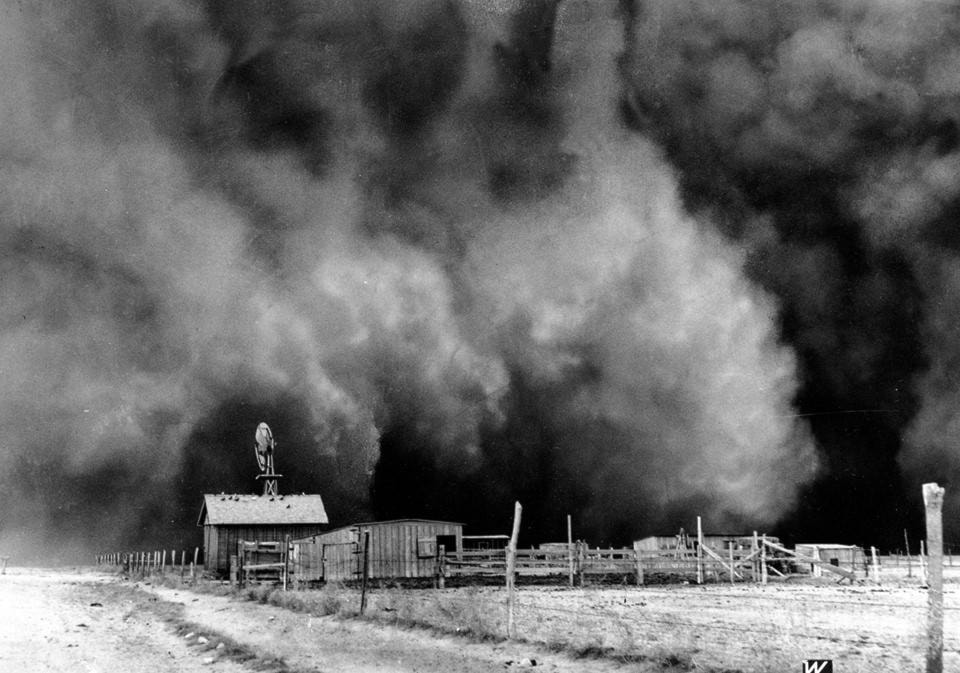On March 3, 1931, 90 years ago, central Alberta was hit by a severe dust storm. There was so much dust swirling in the air that people in Red Deer had to turn on their lights in the middle of the afternoon in order to see. By nightfall, some snow began to fall. However, while that cut down the dust somewhat, very little snow actually fell.
The climate of Western Canadian prairies is well known for its prolonged alternating periods of dry, wet, warm and cold weather. The winter of 1930-1931 was unusually warm and dry – in the terminology of the time, “an open winter.” One sign of the very dry conditions was a sizeable forest fire by Rocky Mountain House, which had started well before the early March dust storm hit.
It was very unusual to have notable fires and large dust storms before the start of spring. Consequently, there were lots of comments about the unprecedented conditions. What people didn’t realize was that this was actually one of the first signs of one of the greatest environmental disasters in the history of western North America – the start of the great Dust Bowl, which led to the decade being dubbed the Dirty Thirties.
While the onset of a multi-year drought was a major factor in this disaster, so were the widespread farming practices of the time. The native prairie grasslands and natural groves of trees had been broken up as the region was turned into farmlands. Moreover, land was often heavily cultivated, with stubble being burned off as a form of weed control. That made for fine, loose soils, with little ground cover to control wind erosion.
The March 1931 storm was soon followed by another wave of widespread dust storms that hit in May. In one dust storm at Ponoka, it was reported that visibility was reduced to a mere 10 metres.
To add to the grim conditions, there were widespread outbreaks of grasshoppers over the summer that consumed a good deal of the green growth which had emerged. Those infestations continued in subsequent years.
Conditions remained grim in 1932. In April 1932, there were reports of trains being held up by large dust storms in south eastern Alberta and south western Saskatchewan. Starting on May 9, 1934, a massive set of “black blizzards” swept across the Canadian and American plains. Thousands of tonnes of dust reportedly fell on such cities as Chicago. In some communities across the prairies, plows had to be brought out to clear the drifts of soil.
One of the worst set of storms struck on April 14, 1935, dubbed in many media accounts as Black Sunday. Millions of tonnes of soil moved across the plains. There were reports of many lives lost in the horrific storm conditions, several by “dust pneumonia.” In May 1935, a special large health conference was held in the U.S. to discuss the widespread chronic respiratory problems.
New waves of massive dust storms swept across the Western plains in 1936. On May 18, 1937, people in Red Deer again had to turn on their lights in mid-day in order to see. Several had to repaint their homes and businesses afterwards to repair the storm’s “sand-blasting.” In October, people in Rocky Mountain House area were complaining about the thick coatings of dust on window sills and other flat surfaces.
Meanwhile, major government programs were adopted to improve agricultural practices and to reduce the erosion damage of dust storms. One notable one in Canada was the Prairie Farm Rehabilitation Administration (PFRA), which encouraged new cultivation and cropping practices, creation of more pastureland and adoption of water conservation measures such as the installation of farm dugouts.
The return of a cool wet cycle in the early 1940s helped to bring an end to the Dust Bowl. Meanwhile, tens of thousands of farms across the prairies were abandoned and an estimated 3.5 million people moved in hopes of finding better places to live and find sustainable employment. The “Old West” had come to a permanent end.
Red Deer historian Michael Dawe’s column appears Wednesdays.
